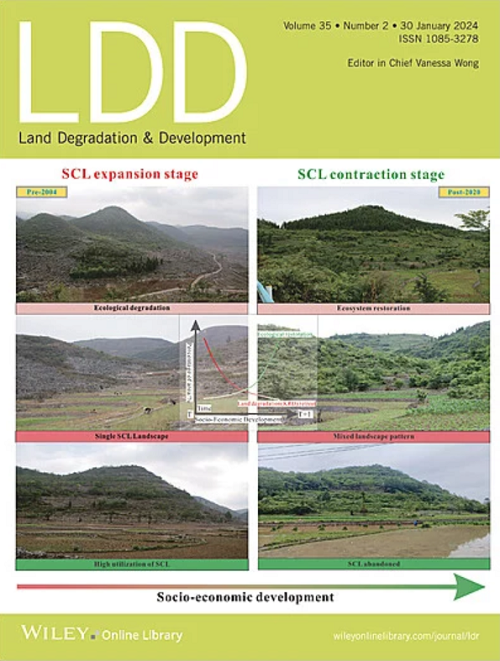Soil Organic Carbon Sequestration Potential, Storage, and Influencing Mechanisms in China
IF 3.6
2区 农林科学
Q2 ENVIRONMENTAL SCIENCES
引用次数: 0
Abstract
The soil organic carbon sequestration potential (SOCsp) has important implications for the global carbon cycle and responses to climate change. However, there is a dearth of spatial information specifically for China within this field, and our knowledge regarding the factors influencing SOCsp remains somewhat limited. To solve this problem, this study utilized legacy soil data collected in the 1980s (1979–1984s), combined with climatic landscape zoning, and adopted digital soil mapping techniques to produce spatial prediction models of the density of soil carbon sequestration potential for five designated depths. The results showed that the accuracy of the top soil (0–30 cm) model was higher than that of the subsoil (30–100 cm) model. SOCsp was highest in northwestern, northern, and eastern China and lowest in the southeastern Tibetan Plateau and northeastern China. Scale- and location-specific effects of environmental factors on SOCs were observed, with two-factor effects being stronger than those of their one-factor counterparts. Spatial differentiation characteristics of drivers between topsoil and subsoil layers show significant climatic zonal differences. In the topsoil layer, climate and vegetation are the dominant factors in the arid zone, while the semi-arid zone is mainly regulated by vegetation and land use; in the subsoil layer, climate and land use together dominate SOCsp in the arid and semi-arid zones. In this study, we provide data support for the SOCsp pathway for climate change mitigation processes, while emphasizing the importance of in-depth studies on the mechanisms of SOCsp dynamics through its driving mechanisms.中国土壤有机碳固存潜力、储量及其影响机制
土壤有机碳固存潜力(SOCsp)对全球碳循环和气候变化响应具有重要意义。然而,在这一领域,中国缺乏专门的空间信息,我们对影响社会经济发展的因素的了解仍然有限。为了解决这一问题,本研究利用20世纪80年代(1979 - 1984年)的遗留土壤数据,结合气候景观区划,采用数字土壤制图技术建立了5个指定深度土壤固碳潜力密度的空间预测模型。结果表明,表层土(0 ~ 30 cm)模型的精度高于底土(30 ~ 100 cm)模型。中国西北部、北部和东部的SOCsp最高,青藏高原东南部和东北部最低。环境因子对soc的影响具有尺度效应和区位效应,双因素效应强于单因素效应。表土与底土驱动因子空间分异特征表现出明显的气候地带性差异。在表层土壤中,干旱区气候和植被是主导因子,半干旱区主要受植被和土地利用调节;在干旱区和半干旱区,气候和土地利用共同主导着土壤生态系统。在本研究中,我们为气候变化减缓过程的SOCsp路径提供了数据支持,同时强调了通过其驱动机制深入研究SOCsp动力学机制的重要性。
本文章由计算机程序翻译,如有差异,请以英文原文为准。
求助全文
约1分钟内获得全文
求助全文
来源期刊

Land Degradation & Development
农林科学-环境科学
CiteScore
7.70
自引率
8.50%
发文量
379
审稿时长
5.5 months
期刊介绍:
Land Degradation & Development is an international journal which seeks to promote rational study of the recognition, monitoring, control and rehabilitation of degradation in terrestrial environments. The journal focuses on:
- what land degradation is;
- what causes land degradation;
- the impacts of land degradation
- the scale of land degradation;
- the history, current status or future trends of land degradation;
- avoidance, mitigation and control of land degradation;
- remedial actions to rehabilitate or restore degraded land;
- sustainable land management.
 求助内容:
求助内容: 应助结果提醒方式:
应助结果提醒方式:


